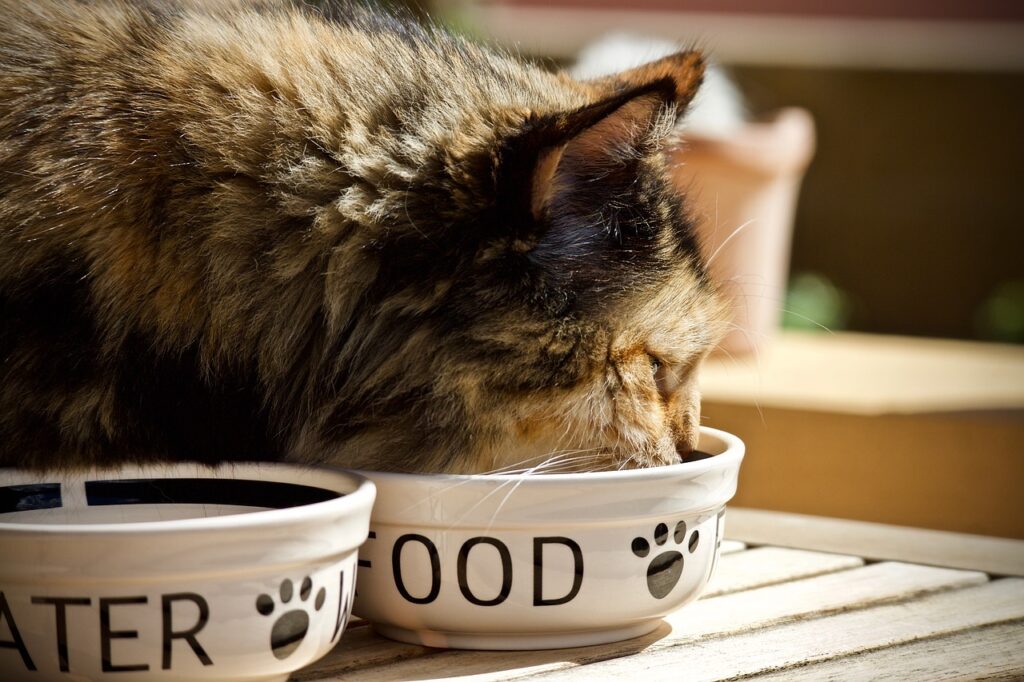Why I No Longer Free Feed
Feeding our feline friends is an important part of being a responsible cat parent/guardian/owner. However, as caring cat-guardian we often make the mistake of free-feeding our cats, leaving food out all day for them to graze on as they please. As a child growing up with cats, my two kitties had a single bowl that they shared (a post for another time) that was constantly topped up with kibble for them to peruse at their leisure. This type of set up is very common even in today’s world.
While free-feeding may seem convenient and like we are doing all the ‘hardwork’ for them, it can have negative consequences on the cat’s physical and mental health. In this post, we will graze on the pitfalls of free-feeding and discover what cat guardians can do instead.

Physical Consequences
Free-feeding cats can lead to obesity, a common problem among cats. When food is constantly available, cats tend to eat more than they need, leading to weight gain. Overweight cats are at risk for several health issues, including diabetes, heart disease, and joint problems (even at a young age).
Free-feeding also makes it difficult to monitor your cat’s food intake, making it harder to identify any changes in their appetite or behaviour that could be a sign of an underlying health issue that needs addressing.
Mental Consequences
Free-feeding can also have negative effects on your cat’s mental health. Cats are natural hunters and thrive on the challenge of finding and catching their food. When food is readily available, cats miss out on this opportunity to exercise their natural instincts, leading to boredom and frustration.
Cats that are free-fed are also at a higher risk of developing anxiety and stress-related behaviours, such as over-grooming, inappropriate scratching, and aggressive behaviour towards other animals or humans.
What Can We Do Instead?
To prevent the negative consequences of free-feeding, cat guardians can implement several strategies to ensure their cats are getting the aproppriate amount of food and exercise for each cat.
- Scheduled Feeding: Instead of free-feeding, create a feeding schedule for your cat. Offer measured portions of food at specific times during the day, rather than leaving food out all the time. This will help your cat develop a routine and prevent overeating for the sake of it. While bowls are the standard for schedule feeding, see below for a better way to serve your cat’s meals.
- Food Puzzle Toys: Food puzzle toys can provide a fun and challenging way for cats to get their food. These toys require cats to work for their food, exercising their natural hunting instincts and keeping them mentally stimulated.
- Interactive Playtime: Playing with your cat is an excellent way to provide exercise and mental stimulation. Engage your cat in interactive play with toys such as feathers, lasers, and strings.
- Provide Safe Outdoor Space: If possible, provide your cat with a safe outdoor space to explore and exercise. This will give them the opportunity to climb, hunt, and explore, providing much-needed mental and physical stimulation. Catios and cat-proof fencing are a great way to allow your cat outdoors safely.
In conclusion, free-feeding cats may seem like an easy way to provide food for your feline friend, but it can lead to negative consequences for their physical and mental health down the road. By implementing a feeding schedule, using food puzzle toys, engaging in interactive playtime, and providing safe outdoor space, cat guardians can ensure their cats stay healthy and happy.
Molly x
Let's Go
Join Me For Free Yoga Classes on InsightTimer
Use this space to advertise your most popular content channel like InsightTimer or YouTube Videos. Put a wee description in here about what you teach.